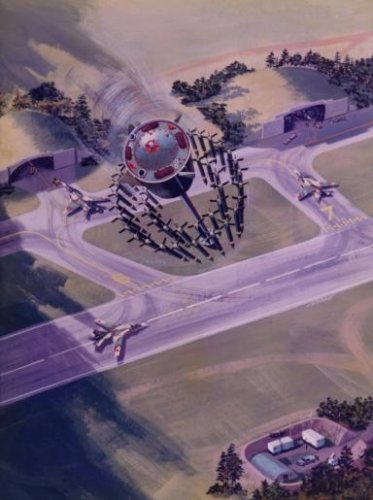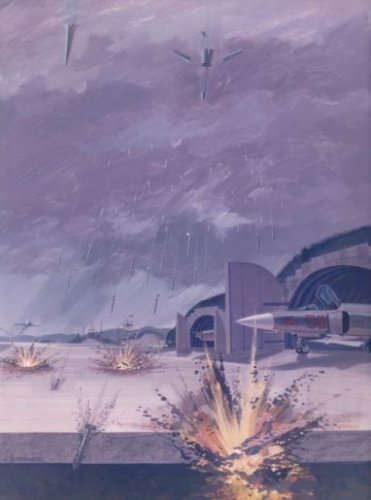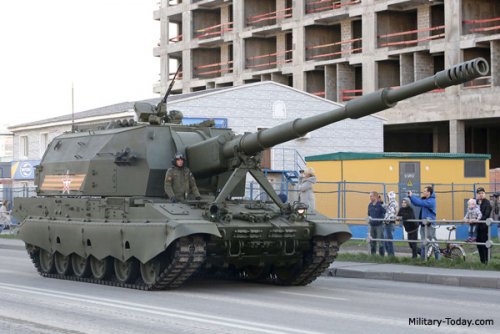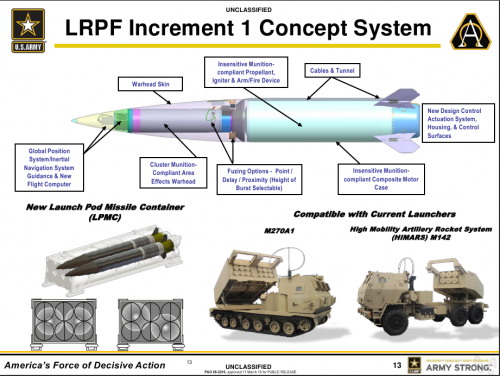You are using an out of date browser. It may not display this or other websites correctly.
You should upgrade or use an alternative browser.
You should upgrade or use an alternative browser.
CSBA "Third Offset" paper
- Thread starter GeorgeA
- Start date
- Status
- Not open for further replies.
marauder2048
"I should really just relax"
- Joined
- 19 November 2013
- Messages
- 3,157
- Reaction score
- 776
Airfield vulnerability is a recurring theme. The Air Force has some ideas on how to recover from airfield damage.
Attachments
-
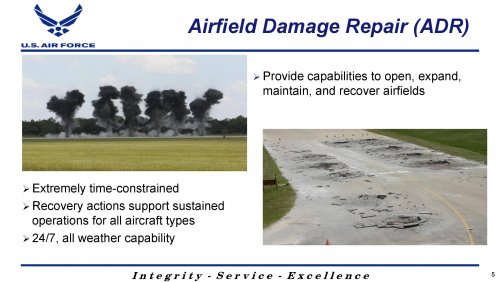 BrianSkibba-airfield-repair-page-005.jpg283.3 KB · Views: 151
BrianSkibba-airfield-repair-page-005.jpg283.3 KB · Views: 151 -
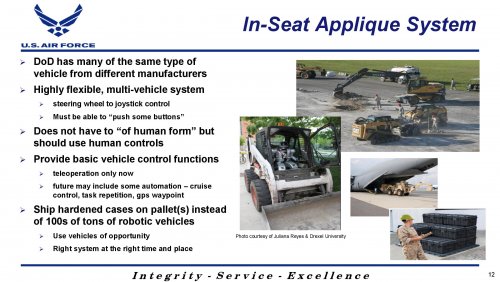 BrianSkibba-airfield-repair-page-012.jpg374.7 KB · Views: 16
BrianSkibba-airfield-repair-page-012.jpg374.7 KB · Views: 16 -
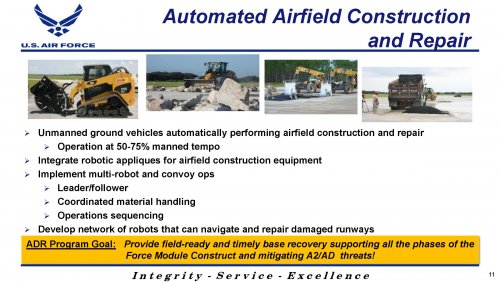 BrianSkibba-airfield-repair-page-011.jpg359.6 KB · Views: 17
BrianSkibba-airfield-repair-page-011.jpg359.6 KB · Views: 17 -
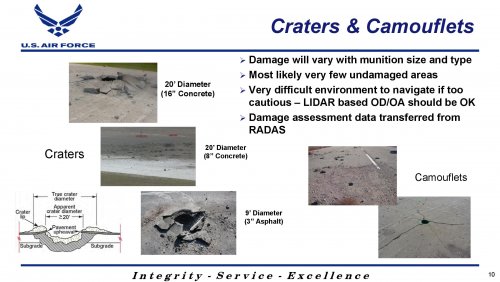 BrianSkibba-airfield-repair-page-010.jpg327.6 KB · Views: 17
BrianSkibba-airfield-repair-page-010.jpg327.6 KB · Views: 17 -
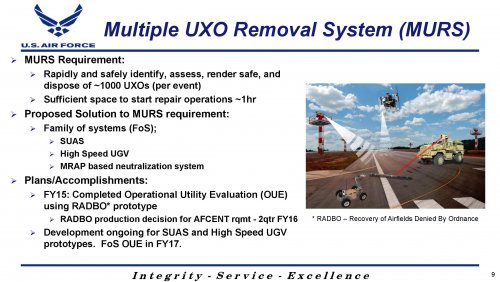 BrianSkibba-airfield-repair-page-009.jpg341.6 KB · Views: 132
BrianSkibba-airfield-repair-page-009.jpg341.6 KB · Views: 132 -
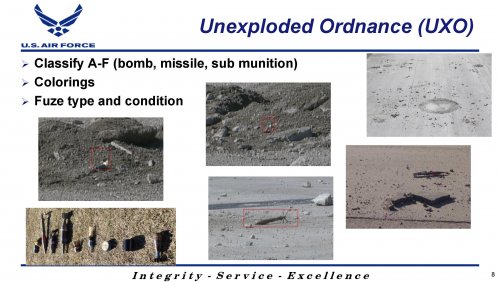 BrianSkibba-airfield-repair-page-008.jpg345.3 KB · Views: 140
BrianSkibba-airfield-repair-page-008.jpg345.3 KB · Views: 140 -
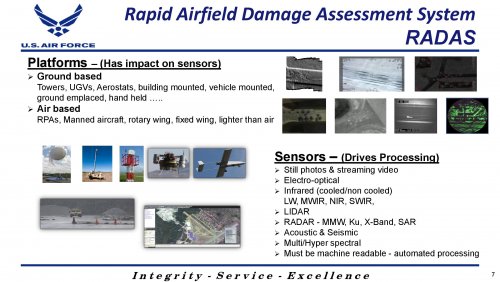 BrianSkibba-airfield-repair-page-007.jpg339.6 KB · Views: 148
BrianSkibba-airfield-repair-page-007.jpg339.6 KB · Views: 148 -
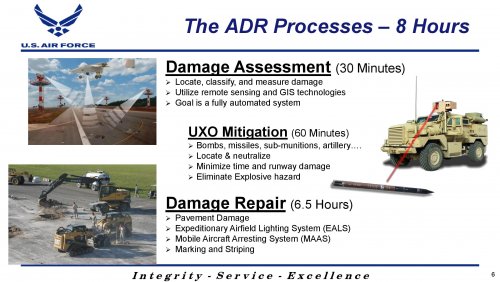 BrianSkibba-airfield-repair-page-006.jpg345.5 KB · Views: 151
BrianSkibba-airfield-repair-page-006.jpg345.5 KB · Views: 151
sferrin said:Would not be at all surprised to see China clone this:
Their so called DF-21D "carrier killer" missile is based on this American concept
- Joined
- 21 April 2009
- Messages
- 13,147
- Reaction score
- 5,988
Brown: Army eyes 'multidomain battle' doctrine
July 29, 2016
The Army is developing a new doctrine of multidomain battle, which has the potential to be as transformative as the AirLand Battle doctrine developed in the 1980s, according to the commander of U.S. Army Pacific.
The effort dovetails with the Army Operating Concept, which centers on the problem statement, "win in a complex world." Gen. Robert Brown told Inside the Army July 28 that in order to address the challenges of such an environment, the service aims to capitalize on the joint force's ability to operate in multiple domains.
Army Chief of Staff Gen. Mark Milley is crafting the service's capstone doctrine, which incorporates multidomain battle and cross-domain fires, as well as joint combined arms maneuver. This involves "moving to a position of relative advantage against the enemy, and doing that with joint forces," Brown said. "Because if you do it one domain at a time, you're moving to a position of relative advantage maneuvering. Most enemies can handle that one domain at a time. But multidomain, cross-domain fires -- that's very difficult to deal with." These methods can help the United States to address the anti-access/area denial threat posed by some nations, he said.
"American military power is joint power," Brown emphasized. "In this complex world, we must take advantage of our joint power, that is also interagency, intergovernmental, multinational with our partners. That's our advantage."
"You've got to present someone that would do you harm with multiple dilemmas," he continued. "If you present them with linear, simple problems, they can respond to that. But multiple dilemmas is very tough."
"In the future, multidomain battle, I think, has the potential to be as significant as AirLand Battle," he said.
Still, Brown said, "we can't afford to completely shift away from" counterinsurgency operations in favor of full-spectrum operations. "We made that mistake post-Vietnam, the Army did, and kind of flushed all the COIN lessons learned. . . . And of course, we developed AirLand Battle, which is extremely successful, but COIN will be with us for a long time to come. This extremist threat is not going away any time soon, so we must keep our eye on that, maintain those lessons, share the lessons learned, and be able to deal with that."
Brown shared his view of the Pacific theater as a "battle lab" in which the Army can test various concepts of operation. The upcoming Army Warfighting Assessment will occur primarily at Ft. Bliss, TX, but also will incorporate data gleaned from Pacific Pathways exercises and other excursions in the USARPAC theater.
"The Pacific has all the challenges that exist anywhere in the world," he said, noting the unpredictability of North Korea, the growing extremist threat in the region, the frequency of natural disasters and humanitarian crises, homeland security challenges, and Chinese actions in the South China Sea. In addition to the challenges posed by "the tyranny of distance," Brown said, "all the Army warfighting challenges are faced out here in the Pacific."
The four-star general hailed Pacific Pathways as key to building readiness and developing skills needed to address new challenges. "You can talk about being expeditionary," he said. "You can talk about being tailorable and scalable, and being able to react. But until you practice it and do it, you're just talking about it. You've got to walk the walk. And Pacific Pathways enables us to walk the walk, and it builds readiness."
Brown, who assumed command May 4, released his guidance for USARPAC on July 15, prioritizing readiness, responsiveness in the region, and caring for soldiers, civilians and families. -- Courtney McBride
July 29, 2016
The Army is developing a new doctrine of multidomain battle, which has the potential to be as transformative as the AirLand Battle doctrine developed in the 1980s, according to the commander of U.S. Army Pacific.
The effort dovetails with the Army Operating Concept, which centers on the problem statement, "win in a complex world." Gen. Robert Brown told Inside the Army July 28 that in order to address the challenges of such an environment, the service aims to capitalize on the joint force's ability to operate in multiple domains.
Army Chief of Staff Gen. Mark Milley is crafting the service's capstone doctrine, which incorporates multidomain battle and cross-domain fires, as well as joint combined arms maneuver. This involves "moving to a position of relative advantage against the enemy, and doing that with joint forces," Brown said. "Because if you do it one domain at a time, you're moving to a position of relative advantage maneuvering. Most enemies can handle that one domain at a time. But multidomain, cross-domain fires -- that's very difficult to deal with." These methods can help the United States to address the anti-access/area denial threat posed by some nations, he said.
"American military power is joint power," Brown emphasized. "In this complex world, we must take advantage of our joint power, that is also interagency, intergovernmental, multinational with our partners. That's our advantage."
"You've got to present someone that would do you harm with multiple dilemmas," he continued. "If you present them with linear, simple problems, they can respond to that. But multiple dilemmas is very tough."
"In the future, multidomain battle, I think, has the potential to be as significant as AirLand Battle," he said.
Still, Brown said, "we can't afford to completely shift away from" counterinsurgency operations in favor of full-spectrum operations. "We made that mistake post-Vietnam, the Army did, and kind of flushed all the COIN lessons learned. . . . And of course, we developed AirLand Battle, which is extremely successful, but COIN will be with us for a long time to come. This extremist threat is not going away any time soon, so we must keep our eye on that, maintain those lessons, share the lessons learned, and be able to deal with that."
Brown shared his view of the Pacific theater as a "battle lab" in which the Army can test various concepts of operation. The upcoming Army Warfighting Assessment will occur primarily at Ft. Bliss, TX, but also will incorporate data gleaned from Pacific Pathways exercises and other excursions in the USARPAC theater.
"The Pacific has all the challenges that exist anywhere in the world," he said, noting the unpredictability of North Korea, the growing extremist threat in the region, the frequency of natural disasters and humanitarian crises, homeland security challenges, and Chinese actions in the South China Sea. In addition to the challenges posed by "the tyranny of distance," Brown said, "all the Army warfighting challenges are faced out here in the Pacific."
The four-star general hailed Pacific Pathways as key to building readiness and developing skills needed to address new challenges. "You can talk about being expeditionary," he said. "You can talk about being tailorable and scalable, and being able to react. But until you practice it and do it, you're just talking about it. You've got to walk the walk. And Pacific Pathways enables us to walk the walk, and it builds readiness."
Brown, who assumed command May 4, released his guidance for USARPAC on July 15, prioritizing readiness, responsiveness in the region, and caring for soldiers, civilians and families. -- Courtney McBride
bring_it_on
I really should change my personal text
- Joined
- 4 July 2013
- Messages
- 3,123
- Reaction score
- 2,234
Enabling Technologies for High-speed Operable Systems (ETHOS)
The overall objective is to identify, develop, mature, and demonstrate technologies that enable refurbishable high speed (M>3) capability for intelligence/surveillance/reconnaissance (ISR) and strike platforms by 2028, and for quick-turn fully reusable systems by 2035.
Background: The High Speed Systems Division within the Air Force Research Laboratory (AFRL) conducts research to develop, demonstrate, integrate and transition high speed vehicle technologies that provide affordable, revolutionary capabilities to the warfighter. Technology developments in high speed systems provide for cost effective weapons and aerospace vehicle platforms capable of accurate and timely delivery of payloads worldwide in support of the Air Force’s desire for rapid, persistent strike/ISR and affordable, responsive space launch. The time frame for development of these capabilities is such that the technologies are demonstrated and matured to a technology readiness level of 6 for mid-term transition in 2025 (persistent engagement) and far-term by 2035 (responsive space launch).
Objective: The overall objective is to identify, develop, mature, and demonstrate technologies that enable refurbishable high speed (M>3) capability for intelligence/surveillance/reconnaissance (ISR) and strike platforms by 2028, and for quick-turn fully reusable systems by 2035. It is envisioned that the earlier demonstration systems will be air-launched utilizing rocket-boost to reach hypersonic cruise speeds, and later employing combined cycle engines that permit runway operations. Those
technologies that advance the state-of-the-art and that mature the science base to high technology readiness levels will be further considered for incorporation into the AFRL strategic plan.
Sub-Tier Objectives: The Technical Objectives below further define the desired technology areas.
1. High Speed Experimental Sciences
2. High Speed Propulsion Systems
3. Aero-Structures
4. Modeling and Simulation (M&S)
5. Vehicle Design and Integration
jsport
what do you know about surfing Major? you're from-
- Joined
- 27 July 2011
- Messages
- 6,565
- Reaction score
- 3,893
bring_it_on said:Enabling Technologies for High-speed Operable Systems (ETHOS)
The overall objective is to identify, develop, mature, and demonstrate technologies that enable refurbishable high speed (M>3) capability for intelligence/surveillance/reconnaissance (ISR) and strike platforms by 2028, and for quick-turn fully reusable systems by 2035.
Background: The High Speed Systems Division within the Air Force Research Laboratory (AFRL) conducts research to develop, demonstrate, integrate and transition high speed vehicle technologies that provide affordable, revolutionary capabilities to the warfighter. Technology developments in high speed systems provide for cost effective weapons and aerospace vehicle platforms capable of accurate and timely delivery of payloads worldwide in support of the Air Force’s desire for rapid, persistent strike/ISR and affordable, responsive space launch. The time frame for development of these capabilities is such that the technologies are demonstrated and matured to a technology readiness level of 6 for mid-term transition in 2025 (persistent engagement) and far-term by 2035 (responsive space launch).
Objective: The overall objective is to identify, develop, mature, and demonstrate technologies that enable refurbishable high speed (M>3) capability for intelligence/surveillance/reconnaissance (ISR) and strike platforms by 2028, and for quick-turn fully reusable systems by 2035. It is envisioned that the earlier demonstration systems will be air-launched utilizing rocket-boost to reach hypersonic cruise speeds, and later employing combined cycle engines that permit runway operations. Those
technologies that advance the state-of-the-art and that mature the science base to high technology readiness levels will be further considered for incorporation into the AFRL strategic plan.
Sub-Tier Objectives: The Technical Objectives below further define the desired technology areas.
1. High Speed Experimental Sciences
2. High Speed Propulsion Systems
3. Aero-Structures
4. Modeling and Simulation (M&S)
5. Vehicle Design and Integration
Makes sense especially if it can deliver ever smaller guided submuntions at some speed at decreasing cost.
Better than a railgun that melts itself untrue (thus more inaccurate) everytime it fires. Oh lets have a support ship full barrels :
Even the Army Tactical Power researchers now seem to acknowledging that fuels rather than capacitors ( batteries) have such superior power density that combustion still makes more sense ..even down to the dismount..
jsport
what do you know about surfing Major? you're from-
- Joined
- 27 July 2011
- Messages
- 6,565
- Reaction score
- 3,893
thank you for posting bobbymikebobbymike said:http://breakingdefense.com/2016/08/what-the-future-of-gps-bombers-fighters-should-be/
this was good article but kinda should be the conventional wisdom by now.. GPS, Space, high low mix. Certainly Darpa Gremlins as it stands is not close to effective high mix solution. Model A phase.
- Joined
- 21 April 2009
- Messages
- 13,147
- Reaction score
- 5,988
The Supercomputer That Can Spot Mobile Missiles
A few months ago, we told you how the Pentagon is looking to automate its search for enemy mobile missile launchers, the kind like North Korea tested earlier this year. Well, we found a small company here in Huntsville that has built a supercomputer that can tell the difference between the good guys and the bad guys.
You can teach the computer, made by Archarithms, what different types of vehicles look like by feeding it images. The company demoed how the deep learning machine works using a small drone with a camera mounted to its belly. The drone flew over models of pickup trucks and mobile missile launches, beaming the video into the supercomputer.
Red circles (signaling the bad guys) and other data popped up on a TV screen, when the drone flew over the missile launcher. It even differentiated between two identical pickup truck, one with a machine gun mounted in its bed and the other with nothing. It’s similar to how Facebook can tell (most of the time) which of your friends are in the pictures you post.
The learning machine is the type of technology the Pentagon is seeking for the “Third Offset,” an initiative to find game-changing tech for weapons of the future. In fact, Deputy Defense Secretary Robert Work expressed to me the need for this type deep learning machine for intel community when we chatted on a flight to Washington after the Reagan National Defense Forum last November.
Joel Hewlett, a systems engineer with company and brain behind the machine, first taught the computer how to play poker. At last year’s conference, they showed off that technology. One year later the computer knows far more than the difference between a flush and a full house.
The small drone with the tiny high definition camera is only a small example of the sensors that could feed the machine info, Hewlett said. In addition to video feeds, from planes, satellites or wherever, the computer could get info from radars.
Company employees a see broad application for the technology beyond the military. They are teaching the machine to read license plates and identify the make and model of a cars. Unlike current sensors that only read license plates, the new tech could then help determine if a car has phony tags.
-----------------------------------------------------------------------------------------------------------
Now a hypersonic strike weapon to attack these targets...........
A few months ago, we told you how the Pentagon is looking to automate its search for enemy mobile missile launchers, the kind like North Korea tested earlier this year. Well, we found a small company here in Huntsville that has built a supercomputer that can tell the difference between the good guys and the bad guys.
You can teach the computer, made by Archarithms, what different types of vehicles look like by feeding it images. The company demoed how the deep learning machine works using a small drone with a camera mounted to its belly. The drone flew over models of pickup trucks and mobile missile launches, beaming the video into the supercomputer.
Red circles (signaling the bad guys) and other data popped up on a TV screen, when the drone flew over the missile launcher. It even differentiated between two identical pickup truck, one with a machine gun mounted in its bed and the other with nothing. It’s similar to how Facebook can tell (most of the time) which of your friends are in the pictures you post.
The learning machine is the type of technology the Pentagon is seeking for the “Third Offset,” an initiative to find game-changing tech for weapons of the future. In fact, Deputy Defense Secretary Robert Work expressed to me the need for this type deep learning machine for intel community when we chatted on a flight to Washington after the Reagan National Defense Forum last November.
Joel Hewlett, a systems engineer with company and brain behind the machine, first taught the computer how to play poker. At last year’s conference, they showed off that technology. One year later the computer knows far more than the difference between a flush and a full house.
The small drone with the tiny high definition camera is only a small example of the sensors that could feed the machine info, Hewlett said. In addition to video feeds, from planes, satellites or wherever, the computer could get info from radars.
Company employees a see broad application for the technology beyond the military. They are teaching the machine to read license plates and identify the make and model of a cars. Unlike current sensors that only read license plates, the new tech could then help determine if a car has phony tags.
-----------------------------------------------------------------------------------------------------------
Now a hypersonic strike weapon to attack these targets...........
jsport
what do you know about surfing Major? you're from-
- Joined
- 27 July 2011
- Messages
- 6,565
- Reaction score
- 3,893
Understand the AEGIS based system has an automated find and even respond system(?) since it was anticipated the human crew would be overwhelmed by Soviet onslaughts.
Assuming humans must be in the loop has already been 'over come by events' so unsure why it is still such an issue. High confidence sensors...
Assuming humans must be in the loop has already been 'over come by events' so unsure why it is still such an issue. High confidence sensors...
- Joined
- 21 April 2009
- Messages
- 13,147
- Reaction score
- 5,988
http://www.nextbigfuture.com/2016/08/high-velocity-projectiles-railguns-or.html?utm_source=feedburner&utm_medium=feed&utm_campaign=Feed%3A+blogspot%2Fadvancednano+%28nextbigfuture%29&utm_content=FaceBook
- Joined
- 21 April 2009
- Messages
- 13,147
- Reaction score
- 5,988
Army developing artillery round with increased strike capability
The Army is scheduled to hold a system requirement review in October for a new artillery round, a munition that is expected to help the service maintain battlefield "overmatch."
The Army is scheduled to hold a system requirement review in October for a new artillery round, a munition that is expected to help the service maintain battlefield "overmatch."
- Joined
- 3 June 2011
- Messages
- 17,299
- Reaction score
- 8,992
bobbymike said:Army developing artillery round with increased strike capability
The Army is scheduled to hold a system requirement review in October for a new artillery round, a munition that is expected to help the service maintain battlefield "overmatch."
They need Crusader (especially if they're going to grab that railgun round and use it for missile defense). Russia saw the light:
Attachments
- Joined
- 21 April 2009
- Messages
- 13,147
- Reaction score
- 5,988
Build a 500km range missile by 2027 using the same carriers As ATACMS? Shouldn't this take like 2-3 years?
http://www.scout.com/military/warrior/story/1703588-army-ground-launched-missile-hits-500-km-2027
http://www.scout.com/military/warrior/story/1703588-army-ground-launched-missile-hits-500-km-2027
- Joined
- 4 July 2010
- Messages
- 2,220
- Reaction score
- 2,110
I'm not sure why you would think that. Let's compare to LRASM, which had a program launch in 2009 and was approved for limited production in 2014. LRASM in air-launch configuration is essentially "just" a JASSM with a new guidance package. LRPF needs a new airframe, motor, warhead(s), launch canister, and either new or borrowed guidance. 2027 to develop, test, and reach IOC is a pretty reasonable, perhaps even optimistic, goal.
- Joined
- 3 June 2011
- Messages
- 17,299
- Reaction score
- 8,992
Moose said:I'm not sure why you would think that. Let's compare to LRASM, which had a program launch in 2009 and was approved for limited production in 2014. LRASM in air-launch configuration is essentially "just" a JASSM with a new guidance package. LRPF needs a new airframe, motor, warhead(s), launch canister, and either new or borrowed guidance. 2027 to develop, test, and reach IOC is a pretty reasonable, perhaps even optimistic, goal.
"Should" in the sense that, "back in the day we fielded stuff much quicker". Considering this new rocket is using current technology in a different shaped airframe, what's the holdup? "Back in the day" they were having to invent new ways of doing things most of the time, they couldn't just grab something off the shelf. Yet another example of how far we've regressed. China and Russia don't seem to have that problem.
- Joined
- 21 April 2009
- Messages
- 13,147
- Reaction score
- 5,988
Obviously our perceptions have changed, this is 11 years to build a ground launched missile. As you clearly put it, it is not like we are starting from scratch with, "Hey what's a missile?" We have 60+ years of this. Didn't we develop Thor and Jupiter 'from scratch" in like 5 years?sferrin said:Moose said:I'm not sure why you would think that. Let's compare to LRASM, which had a program launch in 2009 and was approved for limited production in 2014. LRASM in air-launch configuration is essentially "just" a JASSM with a new guidance package. LRPF needs a new airframe, motor, warhead(s), launch canister, and either new or borrowed guidance. 2027 to develop, test, and reach IOC is a pretty reasonable, perhaps even optimistic, goal.
"Should" in the sense that, "back in the day we fielded stuff much quicker". Considering this new rocket is using current technology in a different shaped airframe, what's the holdup? "Back in the day" they were having to invent new ways of doing things most of the time, they couldn't just grab something off the shelf. Yet another example of how far we've regressed. China and Russia don't seem to have that problem.
DrRansom
I really should change my personal text
- Joined
- 15 December 2012
- Messages
- 669
- Reaction score
- 196
bobbymike said:The Supercomputer That Can Spot Mobile Missiles
This sounds like bog standard machine learning for image recognition. A useful technology but not new?
As for the army weapon, the delay could be because the Army wants the missile to have a non-ballistic trajectory. The iskander apparently has a non-ballistic trajectory to evade missile defenses, the Army may want that capability.
If that is the case, then there is little previous work on those lines?
Also, LOL at buying new ammunition to maintain "overmatch". The Army has the oldest guns of any first rate power. Furthermore, buying expensive guided shells is an awfully pricey way to combat cheap shells fired at longer distances. What I don't get is why there isn't research on achieving say 50% accuracy improvement for under 1000 per round. That seems to be a better research line than more 50k+ excaliber rounds.
jsport
what do you know about surfing Major? you're from-
- Joined
- 27 July 2011
- Messages
- 6,565
- Reaction score
- 3,893
a second to your motionDrRansom said:bobbymike said:The Supercomputer That Can Spot Mobile Missiles
This sounds like bog standard machine learning for image recognition. A useful technology but not new?
As for the army weapon, the delay could be because the Army wants the missile to have a non-ballistic trajectory. The iskander apparently has a non-ballistic trajectory to evade missile defenses, the Army may want that capability.
If that is the case, then there is little previous work on those lines?
Also, LOL at buying new ammunition to maintain "overmatch". The Army has the oldest guns of any first rate power. Furthermore, buying expensive guided shells is an awfully pricey way to combat cheap shells fired at longer distances. What I don't get is why there isn't research on achieving say 50% accuracy improvement for under 1000 per round. That seems to be a better research line than more 50k+ excaliber rounds.
- Joined
- 3 June 2011
- Messages
- 17,299
- Reaction score
- 8,992
DrRansom said:bobbymike said:The Supercomputer That Can Spot Mobile Missiles
This sounds like bog standard machine learning for image recognition. A useful technology but not new?
As for the army weapon, the delay could be because the Army wants the missile to have a non-ballistic trajectory.
ATACMS already has a non-ballistic trajectory so it's not like they've never done it before.
DrRansom
I really should change my personal text
- Joined
- 15 December 2012
- Messages
- 669
- Reaction score
- 196
sferrin said:ATACMS already has a non-ballistic trajectory so it's not like they've never done it before.
Maybe the army wants a more aggressive non-ballistic trajectory? Something with high energy turns to evade defenses? The atacms, iirc, does non-ballistic for superior penetration capability, but not for evasion.
Another issue the army might be facing is how to get cluster bomblet performance from a non-cluster bomb missile. There's been work there but so far nothing concrete.
- Joined
- 3 June 2011
- Messages
- 17,299
- Reaction score
- 8,992
DrRansom said:sferrin said:ATACMS already has a non-ballistic trajectory so it's not like they've never done it before.
Maybe the army wants a more aggressive non-ballistic trajectory? Something with high energy turns to evade defenses? The atacms, iirc, does non-ballistic for superior penetration capability, but not for evasion.
Another issue the army might be facing is how to get cluster bomblet performance from a non-cluster bomb missile. There's been work there but so far nothing concrete.
I don't see how any of that could take eleven years. Just happened to be looking at the Hound Dog (supersonic nuclear cruise missile). Went from proposal submitted to 722 missiles (of two models) delivered in 6 years.
marauder2048
"I should really just relax"
- Joined
- 19 November 2013
- Messages
- 3,157
- Reaction score
- 776
sferrin said:I don't see how any of that could take eleven years.
Three words: Insensitive Munitions compliance. From tip-to-toe on the biggest fire cracker the Army has in its inventory.
Attachments
- Joined
- 3 June 2011
- Messages
- 17,299
- Reaction score
- 8,992
Still don't see how that would take eleven years (given the propellant being used isn't new, or even if it was). And "firecracker" it is compared to land-launched missiles fielded by just about everybody else. (No, I'm not bitter, of course not.)
- Status
- Not open for further replies.
Similar threads
-
-
-
U.S. Transportation Secretary Announces Unmanned Aircraft Registration
- Started by Dragon029
- Replies: 9
-
-


